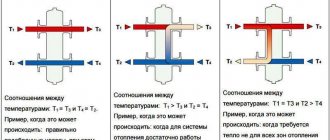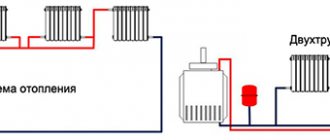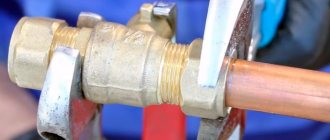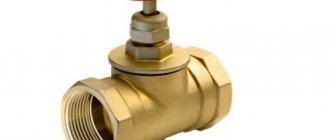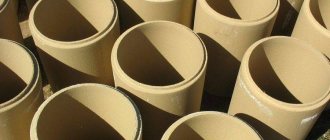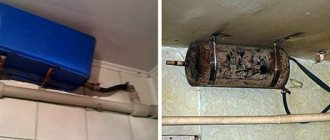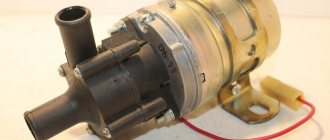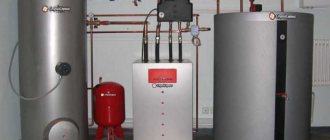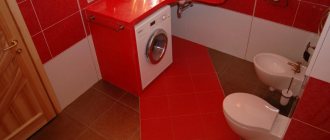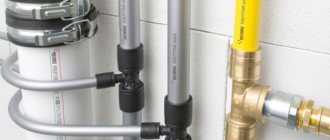A heated towel rail, as an important bathroom accessory, creates a favorable microclimate in this room, prevents the formation of mold, fungi, pathogens and allows you to always have dry, warm towels on hand. However, over time, in Soviet-built houses, their outdated models cease to please the eye and lose their attractive appearance and functionality. Therefore, having decided to change the interior interior or make renovations in the bathroom, many are certainly faced with the question of dismantling, remodeling the location and installing a new heated towel rail. Replacing a heated towel rail and moving it to another wall is a complex and not simple process.
How to correctly replace, move and connect a heated towel rail must be understood before starting repairs, regardless of whether this work will be performed by experienced plumbers or done with your own hands. In any case, this will help control the entire process of construction and installation work and compliance with certain rules.
Water or electric
Today, replacing a heated towel rail in a bathroom can be done with a water or electric option.
Water heated towel rails are produced by manufacturers from:
-Become;
-Stainless steel;
-Chromed brass.
Visually, these devices are the same, but each of them has its own characteristics.
Steel ones are more reliable and can withstand the operating conditions of our heating systems, but to increase their service life they must be solid and made from seamless pipe.
Stainless steel is reliable. Products made from it are not subject to corrosion. For installation in rooms with central heating or hot water supply, the walls of the stainless steel pipe must be more than 3 mm thick.
Brass heated towel rails are presented on the modern market by imported manufacturers. Such products are not suitable for centralized heating systems of Khrushchev and multi-storey buildings, since their maximum permissible operating pressure is 3 atmospheres, which absolutely does not correspond to the operational characteristics of our communication systems.
On the modern market you can find heated towel rails in the form of:
-Ladders;
- Coil;
-Oval, non-standard and asymmetrical configuration.
The most durable device among them is a stainless steel coil.
ELECTRICAL
Electric heated towel rails are chosen for bathrooms if the owners do not want to disrupt the existing heating system. This equipment can operate all year round, even when the heating system or hot water is turned off for maintenance purposes.
Electric dryers come in dry and oil dryers. Heating in them occurs due to internal heating elements or cables built into the silicone sheath. These devices are an excellent alternative to water-based analogues, provided:
-High-quality wiring hidden in the walls;
-Additional built-in machine on the dashboard;
-Reliable grounding.
They are mounted anywhere in the bathroom, but no closer than 60 cm from the washbasin, bathtub or shower.
Do-it-yourself dismantling of an old heated towel rail
How to install a water heated towel rail if the bathroom only has a curved pipe carrying hot water? Before replacing it with a beautiful accessory, it is important to make sure whether it can be covered locally, within the same apartment. If there is no valve, you will have to negotiate with the housing office to block the hot flow in the entire entrance.
After shutting off the main, wait 15–20 minutes for the water to leave the system, and then you can try to change the old heated towel rail. Usually this operation does not cause any difficulties, unless the threaded connection has become “stuck” over time. Then you will need to try to apply some kind of anti-corrosion agent to the joint, and then apply some effort to remove the fasteners. If all else fails, you will have to remove the device using a grinder. Subsequently, deciding how to install the heated towel rail will be a little more difficult; you will have to tinker with the main pipe, making a thread.
Replacing an old heated towel rail
When the old fixture has been removed and everything is ready to connect the new heated towel rail, you should take the opportunity to provide the outlet with an additional pipe, called a bypass, and two ball valves. This is a very useful design that allows you to turn off the water in the future without leaving the bathroom if you decide to change this accessory again.
Modern technologies are such that polypropylene pipes are successfully used for water mains. Now there is no shortage of them, and therefore you can always choose the desired diameter in any construction market. Many experts prefer copper pipelines, considering them more durable and stronger. But for those who decide to do everything with their own hands, without the help of craftsmen, it is still better to use devices of the first category. They are easier to install, and there is no need to purchase tools for cutting metal. In addition, such pipes are absolutely not subject to corrosion and, therefore, are more durable.
Organizational difficulties when replacing and moving a heated towel rail
To obtain a high-quality result, replacing a heated towel rail should be carried out taking into account a complete change:
-All pipes;
-Thermal device;
- Shut-off valves.
Before purchasing all the components and the heating equipment itself, it is necessary to carefully study the work area:
-Talk with your neighbors about the condition of their pipes that go to your apartment and the likelihood of their damage;
-If the neighbors did not change the old pipes, it is advisable to resolve with them the issue of bringing new pipes from your apartment to them, that is, to the adjacent apartments of the neighbors living above and below;
-In this matter, it is very important to replace worn-out pipe scraps inside the ceilings and walls;
-Agree with neighbors to provide access to their communications during repair work.
If you decide to move the heated towel rail to another place or wall, this work must be taken more seriously, as it involves:
-Implementation of an individual project;
-Hydraulic calculations;
- Coordination with the Housing Office.
What are the approximate prices for labor to replace a heated towel rail?
After all the bureaucratic problems are completed, you can begin installing a new towel dryer. There are three ways to mount the unit :
- if the center distance and pipe diameters completely match, there is no need for alteration (the simplest method);
- the use of welding work in the absence of alignment and poor condition of pipes;
- use of threaded connections (the most common option).
At the moment, the approximate cost of replacing a heated towel rail is:
- installation on a ready-made pipe line without adjustment - 1,500 rubles;
- installation on a ready-made eyeliner with adjustment - 12,000 rubles;
- replacement of the unit with installation of a jumper and two taps up to size 3/4 – 15,500 rubles;
- moving the device with pipe connections without bypass – 14,000 rubles;
- moving the unit with pipe connections and installing a bypass – 19,000 rubles.
Otherwise, we can say that the cost of the work depends on the complexity of the entire structure.
To save your own money and save your nerves, if possible, you should resort to the services of companies that have an SRO certificate and take all the hassle of obtaining permission from the housing office. You can use another alternative option to avoid unnecessary problems - an electric towel dryer.
Tips for moving your dryer
To transfer a heated towel rail to another wall with your own hands, you need to foresee some nuances in advance.
1. For a bathtub, you need to select a high-quality, convenient dryer so that you don’t have to change or repair it later.
2. In order not to aggravate good relations with neighbors, they need to be warned in advance about turning off the hot water or heating riser. When powering the heated towel rail from the heating system, it is better to change it in the summer, when the coolant is drained from the riser.
3. To save the useful volume of the room, create a decent interior when moving the heated towel rail to another wall, it is advisable to deepen all the pipes leading to it into the wall, hide them under a false wall or decorative panel.
4. Try to agree in advance on the project for moving the heated towel rail before starting the main work.
5.For unhindered access to pipe maintenance, threaded connections should be made in the most accessible places.
Causes of failure
It is impossible to imagine a modern bathroom without this heating element. It works around the clock - washed clothes and wet towels are hung on the pipes. In addition, in most cases it plays the role of the only radiator in the room, and the health of apartment owners depends on its proper operation. The heat emitted by the product prevents moisture from condensing on surfaces, which is the cause of mold and mildew.
Often, when a heating device fails, replacing it does not completely eliminate the problem. Therefore, it is necessary to understand the reasons for its breakdown and, based on this, carry out the necessary work.
The heated towel rail is exposed to many factors every day. For example, the cause of failure may be the following circumstances:
- Clogged with rust or dirt. In this case, it is enough to shut off the water supply through the riser and clean the system.
- Problems with eyeliner. Here it is better to dismantle the device and replace it with a new one, thus eliminating the specified problem.
- Incorrect operation of services responsible for supplying water to residential buildings.
- Defective goods. Not all modern manufacturers can boast of a fair attitude towards the users of their products. However, it is not always possible to detect non-compliance with standards during the initial inspection.
Attention! If deficiencies are discovered, it is necessary to immediately begin to eliminate them, otherwise the consequences can be the most unpredictable.
Let's start dismantling
If you are the owner of an old metal coil without union nuts, dismantling the old equipment will proceed according to the following instructions:
- Notify utility companies that you need to shut off your water supply. Only if there is a complete absence of water in the pipes can the process of removing them from the system be carried out.
- Use a level to mark the cut areas. To do this, place the tool in a vertical position and, when the desired effect is achieved, make marks with a pencil.
- Start cutting the pipes. Make sure the cut line is perpendicular to the pipe. Next, remove the fasteners and sharpen the chamfers on the cut pipes. Maintain a 45 degree angle. This will be enough for the boat to enter freely.
- Cut the thread using a special machine. If you use a ladle, pre-treat the edges of the product with any technical oil.
The steps above will have to be followed if your bathroom has an old style coil installed during the construction of the house. New models are much easier to dismantle. If the pipes are not hidden in the wall, use pipe cutters to cut the pipes and reinstall the fitting. To dismantle wiring made from polypropylene pipes, you will need a soldering iron.
Attention! If part of the system is hidden under layers of concrete and cement, you cannot do without purchasing an identical element!
Installation of jumper (bypass) and ball valves
The sections of the hot water pipe into which the heated towel rail will be connected must be connected to each other with a jumper. The need for this element that complicates the design is obvious:
It is better to make the line to the bypass from stainless steel pipes.
- if problems arise in the operation of the coil, you will not need to visit the housing office to submit an application for a new water shutoff;
- work on installing and connecting a heated towel rail does not have to be carried out strictly within the established period for which the water was turned off.
This is especially true for those who are waiting to replace a heated towel rail in a Khrushchev building on their own and without sufficient experience.
How does the bypass work (Fig. 1)? If it becomes necessary to turn off the heated towel rail later for repairs, it is enough to close the ball valves at the inlet and outlet of the water flow from the coil. Opening the tap on the jumper at the same time will allow you not to deprive your neighbors in the house of hot water while the coil is being replaced or repaired.
What you will need to install a bypass:
- three ball valves;
- pipe sections of the required length;
- connecting elements: tees with a diameter corresponding to the diameter of the pipeline, 2 pcs.;
- Adjustable wrench.
- Install tees at the ends of the pipe leading to the hot water supply system so that a piece of pipe can be laid between them connecting the water flow in them.
- Connect two short sections of pipe with a ball valve and install this structure between the tee branches. Threaded connections are sealed with FUM tape or linen winding. Open the tap.
- Install ball valves on the remaining free ends of the tees, to which the heated towel rail will subsequently be connected. Move the taps to the “closed” position.
Related article: How to grow pumpkin in the country
With this position of the three taps, water will pass through the jumper without entering the heated towel rail coil.
Installation of fasteners and installation of the coil
To work you will need tools:
Coil installation diagram.
- hammer drill - for drilling holes in concrete;
- screwdriver or screwdriver;
- building level;
- Adjustable wrench.
Brackets and screws with plugs for attaching the coil to the wall are usually supplied with the product. If necessary, you can buy suitable brackets yourself.
- Attach the brackets to the coil.
- An assistant will be required to level the device. Place the heated towel rail in the desired location, leveling it horizontally using a building level. Make marks where holes should be made to attach the bracket to the wall.
- According to the marks, drill holes for the plastic screw plugs. Install plugs in the holes. In the case when the replacement does not occur during repairs, a special tile drill will help to preserve the tiles laid on the walls.
- Attach the body of the heated towel rail to the wall using self-tapping screws, screwing them into the installed plastic plugs through the holes of the brackets.
The coil is connected to the pipeline using fittings of the required configuration, depending on the type of connection of the heated towel rail.
Replacing a coil in a Khrushchev building with a new one is not difficult for independent work. This can be done both during a major renovation, and without much destruction in the bathroom.
The best posts
- Christmas interior: Top 5 design ideas
- How much light do you need for each room? [secrets of home lighting]
- How you can decorate your apartment with garlands for Easter
- How to build a house from SIP panels with your own hands
- DIY bowl of abundance master class made from flowers with video
- ECO-house - advantages and disadvantages of cork floors
- Mastic bow: master class step by step with photos and videos
- Burlap accessories: strength and design
Which heated towel rail to choose?
To choose the right new bath device, you need to take into account 2 main criteria:
- constructive solution;
- type of pipe for heated towel rail.
Coil design
Determine a suitable design as follows:
- With a configuration in the form of the letter M or P, they are suitable for a small room or a separate bathroom. Typically, the heat transfer power of such equipment is up to 500 W.
- “Lesenka” are already design radiators with a more attractive appearance. Their heat transfer rate is wider - 600-2000 W. Such systems will be an excellent solution for a spacious bathroom or a combined bathroom.
Important! Coils of the second type must be installed with a bypass, taking into account the fact that they are more susceptible to destruction due to water hammer.
Pipe materials
Heated towel rail pipes are made from different materials:
- stainless steel alloys;
- chrome steel;
- brass;
- copper;
- bronze.
Important! Heated towel rails with thick walls made of ordinary stainless steel are considered more reliable, durable and best priced. Therefore, whenever possible, install the heated towel rail from this material. As for the connecting pipes, in most cases it is advisable to replace them with a more durable material at the same time as the coil itself. For these purposes, a large assortment of PE pipes is available on the market.
Features of installing a new device
Today there are a large number of varieties of heated towel rails, which greatly complicates the process of replacing an old radiator. The ideal solution would be to purchase a similar unit. But it is not always possible to purchase this type, because the assortment in stores often changes, and old models are replaced with improved products. Therefore, very often a situation arises when you have to either adjust the pipes or continue to look for a prototype with similar parameters. When choosing the latter option, the following factors should be considered:
- Type of heated towel rail. Currently, M-shaped, U-shaped and ladder-type models are produced. They differ in the connection method: ladder - from above or below, coil - from the side. This contradiction does not allow the product to be replaced by a model of a different type.
- They have different sizes and shapes. It should be understood that it will be easier to install a device that closely matches the dimensions of the previous pipes.
- The fundamental point is the distance between the centers of the eyeliners. On average, this value is 40-60 centimeters, but in some cases it can reach up to 80 centimeters. This should be taken into account when installing a new product.
To minimize labor costs, you must also pay attention to the connection diameter. But it’s better not to focus on the points of attachment to the wall - their location is easy to change.
